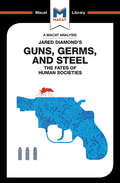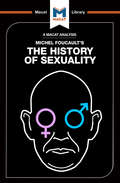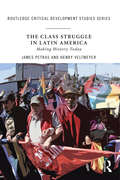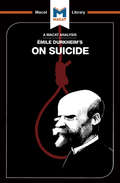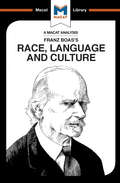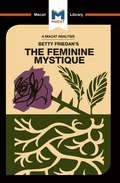- Table View
- List View
Gaia: A New Look at Life on Earth (The Macat Library)
by Mohammad ShamsudduhaGaia: A New Look At Life on Earth may continue to divide opinion, but nobody can deny that the book offers a powerful insight into the creative thinking of its author, James E. Lovelock. Published in 1979, Gaia offered a radically new hypothesis: the Earth, Lovelock argued, is a living entity. Together, the planet and all its separate living organisms form a single self-regulating body, sustaining life and helping it evolve through time. Lovelock sees humans as no more special than other elements of the planet, railing against the once widely-held belief that the good of mankind is the only thing that matters. Despite being seen as radical, and even idiotic on its publication, a version of Lovelock’s viewpoint has found resonance in contemporary debates about the environment and climate, and has now broadly come to be accepted by modern thinkers. As man’s effects on the climate become increasingly extreme, more and more elements of the Earth’s self-regulation seem to be unveiled – forcing scientists to ask how far the planet might be able to go in order self-regulate effectively. Indeed, despite its far-fetched elements, Lovelock’s Gaia thesis seems to ring more convincingly today than ever before; that it does is largely a result of the critical thinking skills that allowed Lovelock to produce novel explanations for existing evidence and, above all, to connect existing fragments of evidence together in new ways.
Guns, Germs & Steel: The Fate of Human Societies (The Macat Library)
by Riley QuinnIn his 1997 work Guns, Germs and Steel, Jared Diamond marshals evidence from five continents and across 13,000 years of human history in an attempt to answer the question of why that history unfolded so differently in various parts of the globe. His results offer new explanations for why the unequal divisions of power and wealth so familiar to us today came into existence – and have persisted. Balancing materials drawn from a vast range of sources, addressing core problems that have fascinated historians, anthropologists, biologists and geographers alike – and blending his analysis to create a compelling narrative that became an international best-seller and reached a broad general market – required a mastery of the critical thinking skill of reasoning that few other scholars can rival. Diamond’s reasoning skills allow him to persuade his readers of the value of his interdisciplinary approach and produce well-structured arguments that keep them turning pages even as he refocuses his analysis from one disparate example to another. Diamond adds to that a spectacular ability to grasp the meaning of the available evidence produced by scholars in those widely different disciplines – making Guns, Germs and Steel equally valuable as an exercise in high-level interpretation.
History of Sexuality: Vol. 1: The Will to Knowledge (The Macat Library)
by Chiara Briganti Rachele DiniMichel Foucault is famous as one of the 20th-century’s most innovative and wide-ranging thinkers. The qualities that made him one of the most-read and influential theorists of the modern age find full expression in History of Sexuality, the last project Foucault was able to complete before his death in 1984. Central to Foucault’s appeal is the creativity of his thought. Creative thinking takes many forms – from redefining an issue in a novel way to making unexpected and illuminating connections. Foucault’s particular talent could perhaps best be described as turning questions inside out. In the case of sexuality, for instance, his interpretation of the historical evidence led him to argue that the sexual categories that we are used to (homosexual, lesbian, straight, and so on) are not “natural,” but constructs that are products of the ways in which power and knowledge interact in society. Such categories, Foucault continues, actually serve to produce the desires they seek to name. And their creation, in turn, is closely linked to the power that society exerts on those who belong to different sexual groups. Foucault’s ideas – familiar now – were so novel in their time that they proved highly challenging. But to see the world through Foucault’s thought is to see it in a profoundly different and illuminating way – an example of creative thinking at its best.
The Class Struggle in Latin America: Making History Today (Routledge Critical Development Studies)
by James Petras Henry VeltmeyerThe Class Struggle in Latin America: Making History Today analyses the political and economic dynamics of development in Latin America through the lens of class struggle. Focusing in particular on Peru, Paraguay, Chile, Colombia, Argentina, Brazil and Venezuela, the book identifies how the shifts and changing dynamics of the class struggle have impacted on the rise, demise and resurgence of neo-liberal regimes in Latin America. This innovative book offers a unique perspective on the evolving dynamics of class struggle, engaging both the destructive forces of capitalist development and those seeking to consolidate the system and preserve the status quo, alongside the efforts of popular resistance concerned with the destructive ravages of capitalism on humankind, society and the global environment. Using theoretical observations based on empirical and historical case studies, this book argues that the class struggle remains intrinsically linked to the march of capitalist development. At a time when post-neo-liberal regimes in Latin America are faltering, this supplementary text provides a guide to the economic and political dynamics of capitalist development in the region, which will be invaluable to students and researchers of international development, anthropology and sociology, as well as those with an interest in Latin American politics and development.
Iran: A People Interrupted (The Macat Library)
by Bryan GibsonHamid Dabashi’s 2007 Iran: A People Interrupted is simultaneously subtle, passionate, polarizing and polemical. A concise account of Iranian history from the early 19th-century onward, Dabashi’s book uses his incisive analytical skills as a basis for creating a persuasive argument against the views of Iran that predominate in the West. In Dabashi’s view, Western approaches to Iran have been colored time and time again by the assumption that it is somehow trapped between regressive ‘tradition,’ and progressive ‘modernity.’ The reality, he argues, is quite the opposite: Iran has its own distinctive ideology of modernity, which is nevertheless opposed to many Western ideals. In order to prove his point, Dabashi draws on a lifetime’s experience of literary criticism to analyse the relationship between Iran’s intellectual and political elites over two centuries. His analysis provides the key evidence for his reasoning by teasing out the implicit assumptions that underly the texts and people he examines. Looking beneath the surface of the evidence, Dabashi finds – time and time again – the traces of a uniquely Iranian notion of modernity that is quite at odds with its Western counterpart.
Liquidated: An Ethnography of Wall Street (The Macat Library)
by Rodolfo MaggioLiquidated is a work of anthropology that treats an unusual, despised subculture – that of the Wall Street banker – much as anthropologists have traditionally treated remote ‘savage’ tribes. But using the techniques of ethnography, including interviews, analysis of daily lives, and fieldwork to investigate a modern western culture is not original; what sets Ho's work apart and gives it value is her mastery of the critical thinking skills of problem-solving and creative thinking to reconceptualize the way in which we understand the bankers' mindset. Ho's great achievement is to ask productive questions, most obviously in drawing a distinction between bankers' self-image as capitalist warriors, freeing up value for themselves and shareholders by increasing the liquidity of the assets they invest in, and the social consequences of what they do. As Ho points out, not only is Wall Street institutionally inclined to embrace risk, in order to maximise profit; it is also prone to assume that increased liquidity (most often achieved by breaking up and selling off the parts of a large corporation) is a good in itself, irrespective of the outcomes for the workers actually involved in these disposals. Considering alternative possibilities, and generating fresh solutions, Ho determines that the capitalist principles that underpin Wall Street are myths, not the expression of some natural economic law..
An Analysis of Arjun Appadurai's Modernity at Large: Cultural Dimensions of Globalisation (The Macat Library)
by Amy Young EvrardArjun Appadurai’s 1996 collection of essays Modernity At Large: Cultural Dimensions of Globalization helped reshape how anthropologists, geographers and philosophers saw and understood the key topic of our times: globalization. Globalization has long been recognized as one of the crucial factors shaping the modern world – a force that allows goods, people, money, information and culture to flow across borders with relative ease. But if globalization is reshaping the world, it is also viewed with increasing suspicion – and it is still not clear how to understand and conceptualise the huge shifts that are taking place. Appadurai’s work is now considered one of the most influential contributions to the field, largely because of its brilliantly creative approach to the conceptual problems posed by the deep and rapid changes that are involved. Critical thinking lies at the heart of the author’s approach to his writing. A common tactic among gifted creative thinkers is to shift a problem or argument into a novel interpretative framework, and this is exactly what Appadurai did. Modernity at Large interrogates modernity through Appadurai’s notion of ‘scapes,’ a set of separate, interacting flows that, he suggests, cross the globalized world: ethnoscapes (the flow of people), mediascapes (flow of media), technoscapes (technological interactions), financescapes (capital flow), and ideoscapes (the flow of ideologies). By constructing this creative framework, it becomes possible to undertake, as Appadurai does, a brilliant and original investigation of what globalization really means.
On Suicide (The Macat Library)
by Robert EasthopeEmile Durkheim’s 1897 On Suicide is widely recognized as one of the foundational classic texts of sociology. It is also one that shows the degree to which strong interpretative skills can often provide the bedrock for high-level analysis. Durkheim's aim was to analyse the nature of suicide in the context of society itself – examining it not just as an individual decision, but one in which different social factors played important roles. In order to do this, it was vital that he both define and classify suicide into subtypes – kinds of suicide with different causal factors at play. From his research, Durkheim identifed four broad types of suicide: egoistic (from a sense of not-belonging), altruistic (from a sense that group goals far outweigh individual well-being), anomic (from lack of moral or social direction), and fatalistic (in response to excessive discipline or oppression). These definitions opened the way for Durkheim to pursue a close social analysis examining how each type related to different social contexts. While his study is in certain ways dated, it remains classic precisely because it helped define the methodology of sociology itself – in which interpretative skills remain central.
On the Origin of Species (The Macat Library)
by Kathleen Bryson Nadezda Josephine MsindaiCharles Darwin called on a broad and unusually powerful combination of critical thinking skills to create his wide-ranging explanation for biological change, On the Origin of Species. It’s one of those rare books that takes a huge problem – the enormous diversity of different species – and seeks to use a vast range of evidence to solve it. But it was perhaps Darwin’s towering creative prowess that made the most telling contribution to this masterpiece, for it was this that enabled him to make the necessary fresh connections between so much disparate evidence from such a diversity of fields. All of Darwin’s critical thinking skills were required, however, in the course of the decades of work that went into this volume. Taken as a whole, Darwin’s solution to the problem that he set himself is carefully researched, considers multiple explanations, and justifies its conclusions with well-organised reasoning. At the time of the publication, in 1859, there were various explanations for the changes that Darwin – and others – observed; what separated Darwin from so many of his contemporaries is that he deployed critical thinking to arrive at a significantly new way of fitting explanation to evidence; one that remains elegant, complete and predictive to this day.
Our Common Future (The Macat Library)
by Ksenia GerasimovaOur Common Future is a joint work produced in 1987 by a United Nations commission headed by former Norwegian Prime Minister, Gro Brundtland. Also known as The Brundtland Report, it offers a classic approach to problem solving by first asking a productive question. How do we protect the world we live in for future generations, while at the same time stimulating economic and social development right now? The solution the work proposes is “sustainable development”, defined in the report as humanity’s ability “to ensure that it meets the needs of the present without compromising the ability of future generations to meet their own needs.” The key conclusion the report came to – that we need long-term strategies to manage the earth’s natural resources – proved to be so universally welcomed it introduced the term “sustainability” into the everyday language of international politics. Solving the problem of workable sustainable development became a hot topic, leading to the birth of a new academic discipline, environmental economics. The book offered a solution to the problem of ensuring sustainable development by highlighting the critical importance of international cooperation.
Our Ecological Footprint (The Macat Library)
by Luca MarazziOur Ecological Footprint presents a powerful model for measuring humanity’s impact on the Earth to reduce the harm we are causing the planet before it’s too late. While some people believe we can find a middle ground between environmental conservation and economic development, or that future technological discoveries will solve the problem, the authors warn that our planet’s limited resources simply can’t support an economic system based on unlimited growth. Our Ecological Footprint offers a valuable tool to help us live more sustainably and safeguard our natural resources for generations to come.
Race, Language and Culture (The Macat Library)
by Anna Seiferle-ValenciaFranz Boas’s 1940 Race, Language and Culture is a monumentally important text in the history of its discipline, collecting the articles and essays that helped make Boas known as the ‘father of American anthropology.’ An encapsulation of a career dedicated to fighting against the false theories of so-called ‘scientific racism’ that abounded in the first half of the 20th-century, Race, Language and Culture is one of the most historically significant texts in its field – and central to its arguments and impact are Boas’s formidable interpretative skills. It could be said, indeed, that Race, Language and Culture is all about the centrality of interpretation in questioning our assumptions about the world. In critical thinking, interpretation is the ability to clarify and posit definitions for the terms and ideas that make up an argument. Boas’s work demonstrates the importance of another vital element: context. For Boas, who argued passionately for ‘cultural relativism,’ it was vital to interpret individual cultures by their own standards and context – not by ours. Only through comparing and contrasting the two can we reach, he suggested, a better understanding of humankind. Though our own questions might be smaller, it is always worth considering the crucial element Boas brought to interpretation: how does context change definition?
Witchcraft, Oracles and Magic Among the Azande (The Macat Library)
by Kitty WheaterThe history of anthropology is, to a large extent, the history of differing modes of interpretation. As anthropologists have long known, examining, analyzing and recording cultures in the quest to understand humankind as a whole is a vastly complex task, in which nothing can be achieved without careful and incisive interpretative work. Edward Evans-Pritchard’s seminal 1937 Witchcraft, Oracles, and Magic Among the Azande is a model contribution to anthropology’s grand interpretative project, and one whose success is based largely on its author’s thinking skills. A major issue in anthropology at the time was the common assumption that the faiths and customs of other cultures appeared irrational or illogical when compared to the “civilized” and scientific beliefs of the western world. Evans-Pritchard sought to challenge such definitions by embedding himself within a tribal culture in Africa – that of the Azande – and attempting to understand their beliefs in their proper contexts. By doing so, Evans-Pritchard proved just how vital context is to interpretation. Seen within their context, he was able to show, the beliefs of the Azande were far from irrational – and magic actually formed a coherent system that helped mould a functional community and society for the tribe. Evans-Pritchard’s efforts to clarify meaning in this way have proved hugely influential, and have played a major part in guiding later generations of anthropologists from his day to ours.
An Analysis of Rachel Carson's Silent Spring (The Macat Library)
by Nikki SpringerRachel Carson’s 1962 Silent Spring is one of the few books that can claim to be epoch-making. Its closely reasoned attack on the use of pesticides in American agriculture helped thrust environmental consciousness to the fore of modern politics and policy, creating the regulatory landscape we know today. The book is also a monument to the power of closely reasoned argument – built from well organised and carefully evidenced points that are not merely persuasive, but designed to be irrefutable. Indeed, it had to be: upon its publication, the chemical industry utilised all its resources to attempt to discredit both Silent Spring and Carson herself – to no avail. The central argument of the book is that the indiscriminate use of pesticides encouraged by post-war advances in agriculture and chemistry was deeply harmful to plants, animals and the whole environment, with devastating effects that went far beyond protecting crops. At the time, the argument directly contradicted government policy and scientific orthodoxy – and many studies that corroborated Carson’s views were deliberately suppressed by hostile business interests. Carson, however, gathered, organised and set out the evidence in Silent Spring in a way that proved her contentions without a doubt. While environmental battles still rage, few now deny the strength and persuasiveness of her reasoning.
Structural Anthropology (The Macat Library)
by Kitty Wheater Jeffrey A. BeckerClaude Lévi-Strauss is probably the most complex anthropological theorist of all time. His work continues to influence present-day thinkers in his field, but he is perhaps even more influential beyond it. As one of the key figures in the development of what is known today as ‘French theory,’ Lévi-Strauss was one of the most important thinkers of the 20th-century. His theories of interpretation, meaning and culture have helped shape the ideas and methodologies of a range of disciplines, above all literature and philosophy. At the heart of Lévi-Strauss’s work are the questions of meaning and where meaning comes from. As an anthropologist, he was primarily interested in what completely different and separate cultures might have in common. Crucially, he saw how common ground resides not on the surface of cultures (i.e., in similar customs), but deep inside invisible background structures of thought. His quest was to peel away the surface of different cultures through careful interpretation, advancing from one layer to another until he discovered the structures that lay behind all of the exterior practices and meanings. Infamously challenging, his work shows interpretative skills working at the highest, most abstract level possible.
The Anti-Politics Machine (The Macat Library)
by Julie JenkinsThe Anti-Politics Machine (1990) examines how international development projects are conceived, researched, and put into practice. It also looks at what these projects actually achieve. Ferguson criticizes the idea of externally-directed ‘development’ and argues that the process doesn’t take proper account of the daily realities of the communities it is intended to benefit. Instead, they often prioritize technical solutions for addressing poverty and ignoring its social and political dimensions, so the structures that these projects put in place often have unintended consequences. Ferguson suggests that until the process becomes more reflective, development projects will continue to fail.
The Bell Curve: Intelligence and Class Structure in American Life (The Macat Library)
by Christine Ma Michael SchapiraHerrnstein & Murray's The Bell Curve is a deeply controversial text that raises serious issues about the stakes involved in reasoning and interpretation. The authors’ central contention is that intelligence is the primary factor determining social outcomes for individuals – and that it is a better predictor of achievement than income, background or socioeconomic status. One of the major issues raised by the book was its discussion of 'racial differences in intelligence,' and its contention that there is a link between the low observed test scores and social outcomes for African-Americans and their lack of social attainment. While the authors produce and interpret a great deal of data to back up their contentions, they ultimately fail to tackle the problem that neither 'intelligence' nor 'race' have widely accepted definitions in biology, anthropology or sociology. In consequence, the book has been termed both ‘racist’ and ‘pseudoscientific’ thanks to what its critics see as both its faulty reasoning and its uncautious interpretation of evidence. The debate continues to this day, with academics on both sides engaged in fierce arguments over what can be argued from the data that Herrnstein and Murray used.
The Feminine Mystique (The Macat Library)
by Elizabeth WhitakerBetty Friedan's book The Feminine Mystique is possibly the best-selling of all the titles analysed in the Macat library, and arguably one of the most important. Yet it was the product of an apparently minor, meaningless assignment. Undertaking to approach former classmates who had attended Smith College with her, 10 years after their graduation, the high-achieving Friedan was astonished to discover that the survey she had undertaken for a magazine feature revealed a high proportion of her contemporaries were suffering from a malaise she had thought was unique to her: profound dissatisfaction at the ‘ideal’ lives they had been living as wives, mothers and homemakers. For Friedan, this discovery stimulated a remarkable burst of creative thinking, as she began to connect the elements of her own life together in new ways. The popular idea that men and women were equal, but different – that men found their greatest fulfilment through work, while women were most fulfilled in the home – stood revealed as a fallacy, and the depression and even despair she and so many other women felt as a result was recast not as a failure to adapt to a role that was the truest expression of femininity, but as the natural product of undertaking repetitive, unfulfilling and unremunerated labor. Friedan's seminal expression of these new ideas redefined an issue central to many women's lives so successfully that it fuelled a movement – the ‘second wave’ feminism of the 1960s and 1970s that fundamentally challenged the legal and social framework underpinning an entire society.
The Gift (The Macat Library)
by The Macat TeamMarcel Mauss’s 1925 essay The Gift is an enduring classic of sociological and anthropological analysis by a thinker who is one of the founding fathers of modern anthropology. The Gift exploits Mauss’s high-level analytical and interpretative skills to produce a brilliant investigation of the forms, meanings, and structures of gift-giving across a range of societies. Mauss, along with many others, had noted that in a wide range of societies – especially those without monetary exchange or legal structures – gift-giving and receiving was carried out according to strict customs and unwritten laws. What he sought to do in The Gift was to analyse the structures that governed how and when gifts were given, received, and reciprocated in order to grasp what implicit and unspoken reasons governed these structures. He also wanted to apply his interpretative skills to asking what such exchanges meant, in order to explore the implications his analysis might have for modern, western cultures. In Mauss’s investigations, it became clear that gift-giving is, in many cultures, a crucial structural force, binding people together in a web of reciprocal commitments generated by the laws of gifting. Indeed, he concluded, gifts can be seen as the ‘glue’ of society..
The Interpretation of Cultures: Selected Essays (The Macat Library)
by Abena Dadze-ArthurClifford Geertz has been called ‘the most original anthropologist of his generation’ – and this reputation rests largely on the huge contributions to the methodology and approaches of anthropological interpretation that he outlined in The Interpretation of Cultures. The centrality of interpretative skills to anthropology is uncontested: in a subject that is all about understanding mankind, and which seeks to outline the differences and the common ground that exists between cultures, interpretation is the crucial skillset. For Geertz, however, standard interpretative approaches did not go deep enough, and his life’s work concentrated on deepening and perfecting his subject’s interpretative skills. Geertz is best known for his definition of ‘culture,’ and his theory of ‘thick description,’ an influential technique that depends on fresh interpretative approaches. For Geertz, ‘cultures’ are ‘webs of meaning’ in which everyone is suspended. Understanding culture, therefore, is not so much a matter of going in search of law, but of setting out an interpretative framework for meaning that focuses directly on attempts to define the real meaning of things within a given culture. The best way to do this, for Geertz, is via ‘thick description:’ a way of recording things that explores context and surroundings, and articulates meaning within the web of culture. Ambitious and bold, Geertz’s greatest creation is a method all critical thinkers can learn from.
The Lonely Crowd: The Lonely Crowd: A Study of the Changing American Character (The Macat Library)
by Jarrod HomerDavid Riesman’s The Lonely Crowd: A Study in the Changing American Character is one of the best-known books in the history of sociology – holding a mirror up to contemporary America and showing the nation its own character as it had never seen it before. Its success is a testament to Riesman’s mastery of one key critical thinking skill: interpretation. In critical thinking, interpretation focuses on understanding the meaning of evidence, and is frequently characterized by laying down clear definitions, and clarifying ideas and categories for the reader. All these processes are on full display in The Lonely Crowd – which, rather than seeking to challenge accepted wisdom or generate new ideas, provides incisive interpretations and definitions of ideas and data from a variety of sources. Above all, Riesman’s book is a work of categorization – a form of interpretation that can be vital to building and communicating systematic arguments. With the aid of his two co-authors (Nathan Glazer and Reuel Denney), he defined three cultural types that formed a perfect pattern for understanding mid-century American society and the changes it was undergoing. The clarity of the book’s definitions tapped directly into the zeitgeist of the 1950s, powering it to best-seller status and an audience that extended far beyond academia.
The Lucifer Effect (The Macat Library)
by Alexander O’ConnorWhat makes good people capable of committing bad – even evil – acts? Few psychologists are as well-qualified to answer that question as Philip Zimbardo, a psychology professor who was not only the author of the classic Stanford Prison Experiment – which asked two groups of students to assume the roles of prisoners and guards in a makeshift jail, to dramatic effect – but also an active participant in the trial of a US serviceman who took part in the violent abuse of Iraqi prisoners in the wake of the second Gulf War. Zimbardo’s book The Lucifer Effect is an extended analysis that aims to find solutions to the problem of how good people can commit evil acts. Zimbardo used his problem-solving skills to locate the solution to this question in an understanding of two conditions. Firstly, he writes, situational factors (circumstances and setting) must override dispositional ones, meaning that decent and well-meaning people can behave uncharacteristically when placed in unusual or stressful environments. Secondly, good and evil are not alternatives; they are interchangeable. Most people are capable of being both angels and devils, depending on the circumstances. In making this observation, Zimbardo also built on the work of Stanley Milgram, whose own psychological experiments had shown the impact that authority figures can have on determining the actions of their subordinates. Zimbardo's book is a fine example of the importance of asking productive questions that go beyond the theoretical to consider real-world events.
The New Jim Crow: Mass Incarceration in the Age of Colorblindness (The Macat Library)
by Ryan MooreMichelle Alexander’s The New Jim Crow: Mass Incarceration in the Age of Colorblindness is an unflinching dissection of the racial biases built into the American prison system. Named after the laws that enforced racial segregation in the southern United States until the mid-1960s, The New Jim Crow argues that while America is now legally a colorblind society – treating all races equally under the law – many factors combine to build profound racial weighting into the legal system. The US now has the world’s highest rate of incarceration, and a disproportionate percentage of the prison population is comprised of African-American men. Alexander’s argument is that different legal factors have combined to mean both that African-Americans are more likely to be targeted by police, and to receive long jail sentences for their crimes. While many of Alexander’s arguments and statistics are to be found in other books and authors’ work, The New Jim Crow is a masterful example of the reasoning skills that communicate arguments persuasively. Alexander’s skills are those fundamental to critical thinking reasoning: organizing evidence, examining other sides of the question, and synthesizing points to create an overall argument that is as watertight as it is persuasive.
The Politics of Piety: The Islamic Revival and the Feminist Subject (The Macat Library)
by Jessica Johnson Ian FairweatherSaba Mahmood’s 2005 Politics of Piety is an excellent example of evaluation in action. Mahmood’s book is a study of women’s participation in the Islamic revival across the Middle East. Mahmood – a feminist social anthropologist with left-wing, secular political values – wanted to understand why women should become such active participants in a movement that seemingly promoted their subjugation. As Mahmood observed, women’s active participation in the conservative Islamic revival presented (and presents) a difficult question for Western feminists: how to balance cultural sensitivity and promotion of religious freedom and pluralism with the feminist project of women’s liberation? Mahmood’s response was to conduct a detailed evaluation of the arguments made by both sides, examining, in particular, the reasoning of female Muslims themselves. In a key moment of evaluation, Mahmood suggests that Western feminist notions of agency are inadequate to arguments about female Muslim piety. Where Western feminists often restrict definitions of women’s agency to acts that undermine the normal, male-dominated order of things, Mahmood suggests, instead, that agency can encompass female acts that uphold apparently patriarchal values. Ultimately the Western feminist framework is, in her evaluation, inadequate and insufficient for discussing women’s groups in the Islamic revival.
An Analysis of Richard Dawkins's The Selfish Gene (The Macat Library)
by Nicola DavisRichard Dawkins provides excellent examples of his reasoning and interpretation skills in The Selfish Gene. His 1976 book is not a work of original research, but instead a careful explanation of evolution, combined with an argument for a particular interpretation of several aspects of evolution. Since Dawkins is building on other researchers’ work and writing for a general audience, the central elements of good reasoning are vital to his book: producing a clear argument and presenting a persuasive case; organising an argument and supporting its conclusions. In doing this, Dawkins also employs the crucial skill of interpretation: understanding what evidence means; clarifying terms; questioning definitions; giving clear definitions on which to build arguments. The strength of his reasoning and interpretative skills played a key part in the widespread acceptance of his argument for a gene-centred interpretation of natural selection and evolution – and in its history as a bestselling classic of science writing.

